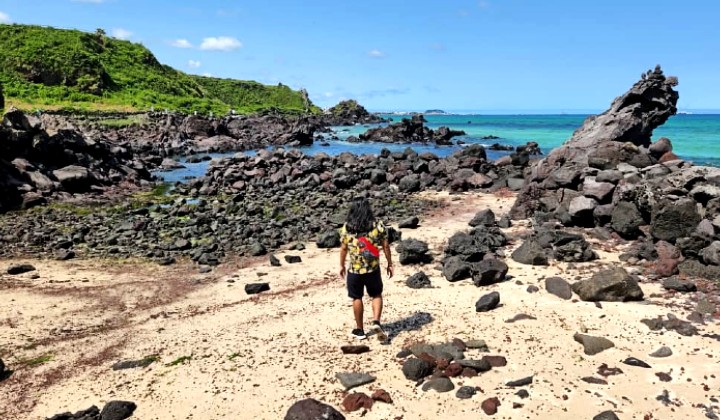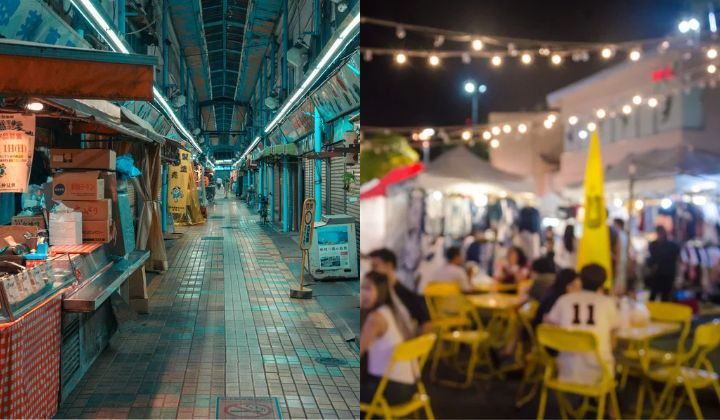I Hate K-Pop But Was Charmed By A Summer Getaway On Jeju Island
Far removed from the bustling scene of Seoul or Busan, Jeju-do, is a mesmerising volcanic island where the sky meets the sea.

Subscribe to our Telegram channel for the latest stories and updates.
I never really understood the appeal people, especially Malaysians, have towards South Korea and how the K-wave of pop culture swept across our shores with its K-music, K-shows and K-brands.
But when the Jeju Tourism Organization came knocking with an invitation to its Special Self-Governing Province, I was eager to fling myself into the swells and experience first-hand what Hanguk has to offer.
Although I’m a little flustered to say that I went there completely blind, with barely any preparation besides learning a few words like Annyeonghaseyo and Go map seum ni da to get by on my adventure.
With my TRP buddy Ken Joe Tai in tow, we set off with a Malaysian tour group on a 4,000 km journey across the seas to Jeju Island, described as the jewel of Korea.
And needless to say, the island life had me saying Saranghae in no time.
The Island of Goddesses and Grandfathers
Far removed from the bustling scene of the Republic’s larger metropolitan areas like Seoul or Busan, Jeju-do, as the locals call it, is a volcanic island located just a ferry ride away from Korea’s mainland. The island is dotted with quaint towns, slumbering villages, spectacular landscapes that are registered as UNESCO’s world natural heritage sites, and all the chill vibes one could ask for.
A place that’s rich in natural wonders, history and legend, the island is sometimes called Samada-do, meaning abundant in rocks, wind and women. In fact, local legend attributes the island to 18,000 different deities, many of them female, and at the top of the island’s pantheon sits Seolmundae, the goddess grandmother who created the island.
It can be said that the spirit of the goddess lives on to this day in the women of Jeju-do. According to our tour guide, since ancient times, the women of Jeju-do were providers who took on gruelling work to farm the lands and dive the seas.
Jeju-do is still famous for its Haenyeo or sea women who free-dive to harvest the island’s abundant platter of seaweed, molluscs and other things to put food on the table.
As you wander around Jeju-do, you’ll also see these stoic stone statues known as Dolhareubang or the Stone Grandfather everywhere — even made into cute souvenirs you can bring along with you. He’s basically the island’s mascot.
I’ve been told two separate stories explaining the grandfather’s significance and origin: One was that the sculptures are carved from volcanic rock and placed in front of ancient palaces on the island as symbols of prosperity, fertility and protection. There are two sides to the Stone Grandfather’s character: a warrior and an intellectual. This depends on the placement of his hands on his chest and belly.
The other, speaks of the Dolhareubang’s rather sad origin. Some say that there was once a husband who turned to stone awaiting the return of his beloved wife who never came back from the sea.
The Island of Sky and Sea
Nature’s magnificence is on full display on Jeju-do. The island is sandwiched between the sky and the sea, and sprinkled with mountain peaks, green plains, shallow creeks, serene forests, and stunning coastlines embraced by a dazzling blue glow. There’s no shortage of romantic, picturesque views to catch your eye, and I’ve been told that the island is a favourite set-piece for famous K-dramas and K-movies.
We were welcomed to the island by Jeju’s June summer when the sun is out from as early as 5 am and only disappears completely past 8 pm. Summertime on the island is warm and breezy with periods of drizzle in between, so it can get a little chilly if you’re walking around in shorts. But that didn’t stop us from exploring the isle to our heart’s content.
The highlight of Jeju-do is, of course, its splashy seaside, where black volcanic rocks, white sandy beaches, lush greenery, colourful flowers and iridescent blue seas intertwine.
On the island’s northwest side is the Aewol Handam Coastal Trail located close to the Jeju International Airport. Here, we breathed in the salty ocean aroma and went on a scenic walk down a paved footpath snaking between the cliffside and the seas that stretch as far as the eye can see, before chilling back to enjoy some refreshing drinks at the many cafes there by the beach.
On the island’s northeast side lies the coastal town of Gujwa-eup, popular for its seaside lodgings, hip cafes and squid jigging scene. In fact, you can see locals hanging their nightly catches out to dry in the hot summer sun just by the roadside.
We were fortunate enough to take a unique “Bike and Clean” cycling tour of the town catered by BY100 — taking in the laid-back surroundings and stopping by to do some good by cleaning up the beaches with our bare hands while being treated to a juicy popsicle along the way.
On the eastern tip of the island stands Seongsan Ilchulbong or the Sunrise Peak. The mountain was formed thousands of years ago by a volcano that erupted under the ocean, creating its famous disk-shaped crater at the top.
Hiking up the peak took us about 30 to 40 minutes of sweating up a winding stairway. But the panoramic view of the sea and the town that lay in the shadow of the mountain was definitely worth the climb. I’ve been told that the best time to scale the mountain was in the wee hours of the morning in order to catch the sun rising above the horizon.
The Forests of Enchantment
Further inland are Jeju-do’s dense and enchanting temperate and subtropical forests. A stop that became my favourite on the trip was the Seogwipo Forest of Healing — a peaceful and mystical woodland filled with tall, shady trees. The best way for me to describe the Healing Forest is that it’s an outdoor spa retreat for the mind, body and soul, surrounded by nature, and a refuge for the weary.
Here, we were taken on a special trek into the forest led by a quiet older man whose wisdom was as deep as the roots of the mighty cedar that grow there. As we hiked into the wilds, the old man would ever so often share insights about life — telling stories through the forest’s flora.
We were then treated to a short meditative nap on hammocks hanging under the canopy — dozing off to the sound of birds and bugs singing among trees and the breeze whispering through the leaves before getting a chance to soak our feet in a warm bath and enjoy a herbaceous meal at the end of the journey.
At night, we ventured into another forest near the island’s Mysterious Road on the foot of Mount Hallasan – the tallest peak on Jeju-do – for a one-of-a-kind Jeju Night Snap photo shoot under the stars directed by professional photographer, Jay from Soom Studio who personally takes and edits enchanting portraits of his subjects in the dead of night.
But if you’re more of a selfie kind of person, a notable stop on your Jeju journey should be the Sanyang Gotjawal Forest, an enclave that our guide said was created by local farmers to preserve the area from development by making it into an Insta-worthy spot with tonnes of props and backdrops.
The City That Barely Sleeps
Jeju-si is the teeming metropolitan serving as the capital city of Jeju-do. It’s a great place to start your adventure because this is where the airport and the main harbour is, and you can get anywhere on Jeju from the city by simply taking the public bus.
Plus, you can practically go everywhere in the city just by walking around as its pedestrian infrastructure is top-notch with sidewalks and street crossings at every corner.
The city’s rhythm is both mellow and lively with a pleasing mix of the old and new. Here is where we got a chance to experience the famous Korean city lifestyle in full swing, albeit at a much slower pace than on the mainland.
When the sun is up, you’ll see everyday citizens going about their day, but at night is when the city truly comes alive with an array of eateries, coffee shops, bars, pubs, and nightclubs that lure you in with their gleaming neon displays.
Jeju-si’s Nuwemaru Street is definitely a must-stop if you’re looking to experience the city’s nightlife. The party here starts at around 11 pm and remains animated till the break of dawn. But since the pandemic, there are shops that close early, so it’s best to plan your stops accordingly.
If you’re looking to do some snacking, head to the city’s Dongmun Market for authentic Jeju street food or make a stop by the Shilla Duty Free mall for some souvenir shopping. You can also catch a bird’s eye view of the city on top of Jeju’s Grand Hyatt Hotel and Jeju Dream Tower, the tallest buildings on the island.
Touristy Things To Do
Being a popular destination for local and foreign tourists alike, Jeju-do hosts a myriad of amusement parks and family-friendly attractions for all. We had a blast visiting Jeju’s Snoopy Garden and got a chance to meet the colourful cast of the classic Peanuts comic strip.
There’s an indoor museum where you’ll learn more about Snoopy, Charlie Brown, the rest of the gang and their imaginative creator. Outside is a charming garden featuring iconic scenes and set-pieces from the comic brought to life.
For a bit of adventure, I’d definitely recommend heading to the Jeju Monolith 9.81 Park where the main attraction is a high-speed, non-motorized, gravity-fed go-kart racing course where you’ll get to zoom down a hill at 40 km per hour and race with friends or strangers.
There’s also a host of other activities to do at the park, like fun arcade games, shooting a few rounds of laser tag and more.
If you’re looking to get your mind blown, then the Arte Museum’s immersive digital art displays are definitely a stop you wouldn’t want to miss. The museum showcases mesmerising displays of classic and modern art with a mixture of lights, sounds and touches to delight the senses.
One of my personal favourite exhibitions here was the #2 Garden where the masterpieces of Vincent van Gogh and other renaissance artists are projected on one huge canvas that surrounds you while classical music like Beethoven’s Moonlight Sonata gently plays in the background. The museum’s Tea Bar is also a wonder to experience as drinks are served on an interactive display table.
Another main attraction in Jeju-do is definitely its delightful delicacies. If you’re a carnivore like me, you might be turned off at first by their main diet of vegetables and seaweed. But I personally assure you that they’re worth a try in Jeju as the island’s volcanic soil produces some of the best greens you can find.
Dishes like the traditional Siraegi-guk — a radish-based soup dish served with rice mixed with spinach and sides of other vegies like fried eggplant, tofu, cabbage and some grilled mackerel makes for quite a filling meal any time of the day. The island is also famous for its fresh seafood like crabs, abalone and other sea critters harvested straight from Jeju’s waters.
For the Haram crowd, another Jeju speciality is its black pork, best eaten in classical Korean BBQ style where you have to cook it yourself over a charcoal grill. And savouring some Korean beer mixed with soju would definitely lighten up the mood of your evenings on the island.
If you’re looking to make your own sweet treats, the Toto Atelier cafe’s self-baking class is a good place to brush up on one’s pastry skills. Here, we got a chance to pick fresh vegetables, herbs and flowers from the garden to be mixed and baked into tasty pies and cakes with our own two hands, guided by the cafe’s expert bakers.
The island is also famous for its tea and coffee culture. We managed to make a pit stop at the Osulloc Tea Museum to sample some of the island’s finest brews and tea-based products. I personally took home a jar of their special green milk tea spread that makes a creamy matcha-infused addition to a breakfast toast.
Travelling to Jeju
If my humble travelogue sparked your interest in making a trip to Jeju-do, then there are a few things you’d need to know to prepare for your island adventure:
- Jeju has four seasons each with its own unique atmosphere, so do choose the time of year when you want to explore the island whether it be in spring, summer, fall or winter, and remember to dress appropriately for the weather.
- Korea’s post-pandemic rules are pretty relaxed. On Jeju, you can walk around outdoors without wearing a facemask, but you are still required to wear one indoors and maintain physical distancing.
- Brush up on your Korean! Most of the islanders you’ll meet speak little to no English, so it’s best to pick up a few phrases to aid in your journey. But, there are some service workers, particularly those who work at hotels, eateries and bars who speak Chinese due to the number of tourists from China that vacation there.
- Malaysians are allowed up to 90-days of visa-free entry into Korea, and Jeju’s no-visa system allows foreigners up to 30-days of entry without one. But visitors must apply for an online Korea Electronic Travel Authorization (K-ETA) that must be approved before departure. It takes at least 72 hours for the K-ETA to be processed and is valid for two years. So do plan ahead.
- Post-pandemic regulations in Korea do allow unvaccinated travellers to enter the country without undergoing mandatory quarantine. But travellers must have a negative PCR (valid for 48 hours) or RTK (valid for 24 hours) test result prior to departure. It’s also mandatory to apply for a Korean Q-Code which holds all your necessary health information. Have these documents printed out and save a backup copy on your phone, along with your Malaysian vaccination certificate, if you have one, which you can get on the MySejahtera app, just in case.
- Visitors are required to perform another Covid-19 test 72 hours upon arrival to Jeju but it’s recommended that you do it as soon as you arrive on the first day. This can be done at any clinic or hospital. You can simply walk into any of these listed facilities to get it done. For the entire list of facilities and more details, just download this helpful fact sheet.
- For smokers and vapers, the entire island of Jeju is a smoke-free zone and you are only allowed to smoke or vape in designated areas. But, when in Rome, as they say: if you see locals lighting up (usually in secluded spaces) it’s probably safe to take a puff without getting fined.
- Follow the rules! This isn’t Malaysia so jaywalking is a no-no. Use the zebra crossings as cars would stop for pedestrians instead of the other way around, and please dispose of your trash appropriately. Try not to drink alcohol openly in public or pick the flowers you’ll see everywhere on the island.
- Have a blast on your Jeju-do adventure!
Share your thoughts with us on TRP’s Facebook, Twitter, and Instagram.
Typing out trending topics and walking the fine line between deep and dumb.





